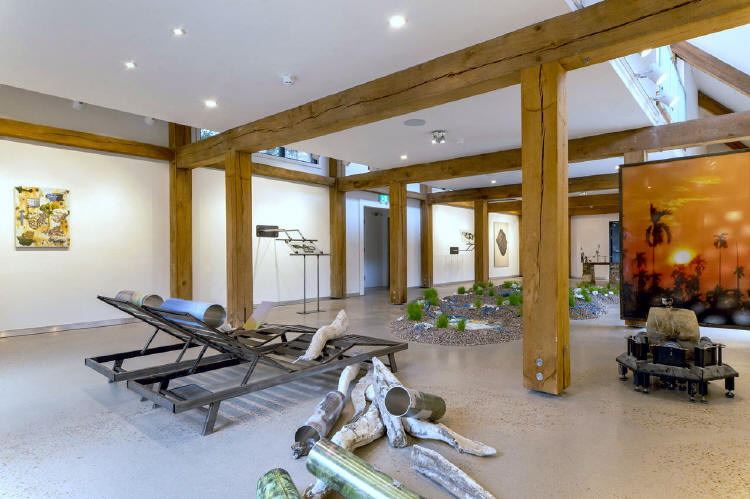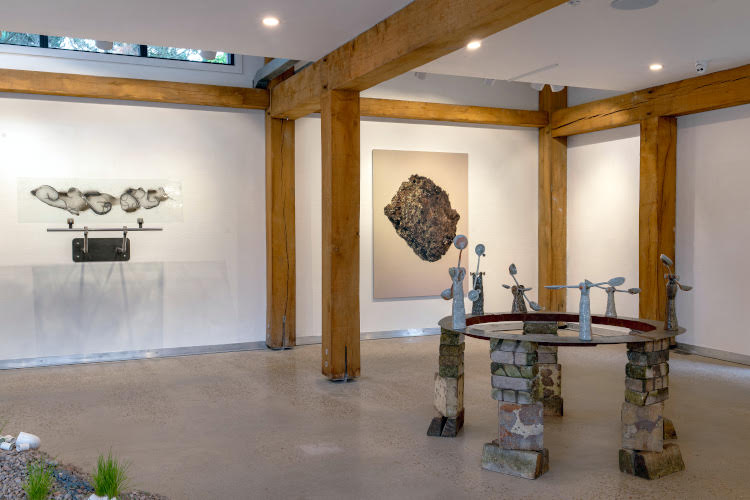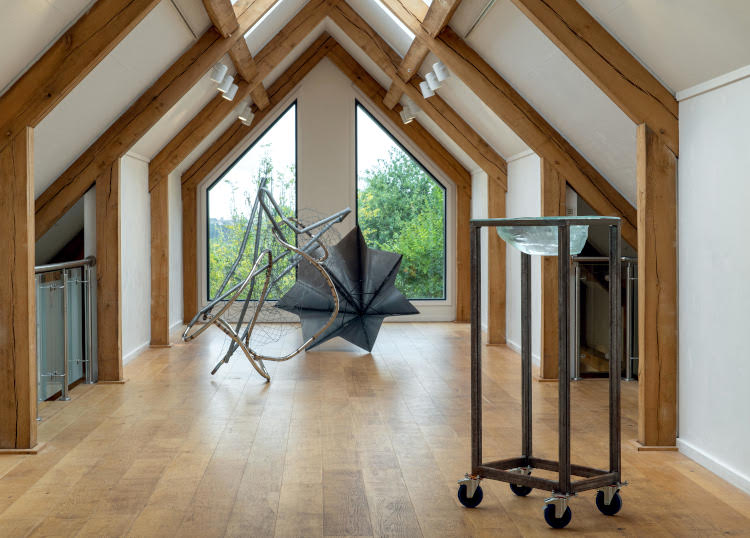|
|
| home | exhibitions | interviews | features | profiles | webprojects | archive |
|
Sediment of Sleep at Tremenheere Sculpture Gardens Martin Holman
Art is about stuff. Artists learn on the job about materials, their source, properties and durability, and what messages their use sends out to the world. Artistic practice involves itself obtaining and moving materials, working them and combining them. Those fundamental concerns become creative catalysts in the current exhibition at the Gallery at Tremenheere Sculpture Gardens outside Penzance, organised by the Cornwall-based artist partnership of ATOI, Amy and Oliver Thomas-Irvine.
“Sediment of Sleep” brings together six artists who explore in their practices how diverse materials communicate ideas and associations to their audience through experiences we share related to texture, weight, scale, surface, shape and usage. Deviation from the familiar meeting points becomes as potent as the expected, with the result that imagination and the senses are constantly stimulated. Entering the lower area is like crossing the threshold into a hardware and aggregates store – but one that has been imaginatively crossed with a laboratory where elements are mixed. Stretching out across the concrete floor is a broad expanse of loose rubble and soil, gravel and dust. Its irregular rim resembles a pool in the landscape, which would not be out of place in the extensive Tremenheere garden itself where plants and wildlife gather. The composition of the pool's banked up edges includes fragments of crystal and minerals, like talc and salt, and shards of quartz. Looking reveals this array. The same scrutiny, however, uncovers unexpected ingredients: plastic-covered wire, ducting and other hard, shiny synthetic substances: the products of industry, not nature. Then there is the incongruity of location.
This pool appears indoors, surrounded by ceiling, walls, lights and columns. Extending the encounter into uncertainty is a length of vinyl tubing. It snakes towards the interior, which is not free-moving water but a watercolour painting. Yet sprouting from the rim are stems of wheat grass, living components which prom8se growth and change in return for regular care from gallery staff. Artist Rachael Champion created the installation especially for this show. This artist is used to working with public locations, encouraging people to interact with sculpture. She often relates the physical make-up of her work – its look, position and materiality – to the ecology of modern environments. Champion calls the expansive piece “Clastic Corpus”, borrowing a term from geology to describe the complex make-up of rocks with constituent particles embedded within it. Industrial products are similarly dependent on earth resources for their manufacture. We can easily lose sight of the link when man-made architecture and fountains become more familiar as neighbours than stone, plants, rivers. Adjacent to the pool are the hard, rectilinear metal shapes of “Overslept” (2025) by the artist duo Amy and Oliver Thomas-Irvine. Side by side, two gently curving horizontals assume the shape of sun loungers. The image of relaxation, they look steely grey and resilient, sleek and cool. Yet, if laid out in the sun, as temperatures are forecast to rise, the seat would burn any bather. Fantasies of leisure suddenly halt. Anomalies also surround "Overslept". The structure is not abstract; it reproduces the form of an almost household object with an identifiable function. People use sunbeds and this version invites the body to stretch out. But the work occupies the situation from which the figure is excluded by convention ("don't touch the artwork") and by the absence of essential comforts, like cushions. A bronze plate juts from an arm rest and glows like a computer screen. And that remains noticeably vacant. What is present, however, is the "thingness" of the objects. The contours belong to a replica; the frame is hard steel, the headrest a roll of vinyl, and placed around its perimeter are husk-like casts (derived from an eel) and desiccated lifeforms, such as molluscs. Do the last of these imply a future creature adapted to climate raised beyond human tolerance?
In fact, each artist in this exhibition has space for the body in their work without ever depicting it explicitly. Instead, indirect connections occur – in shapes and sizes, and in the labour viewers sense was involved in sourcing and making, transporting and lifting materials and objects. And the visitor, having stepped into the gallery, can choose to assume the role of the missing person, at least imaginatively. Rosanna Martin’s sculpture “Belly Bup” (2025) transforms raw material in ways vibrant with potential for a range of personal interpretations. She rests a ring of thin steel at knee height on five columns composed of stained and abraded bricks of different, roughly rectangular shapes. These components have the textures of past use; Martin found them abandoned and recycled them for their previous lives into a new artwork. Then, spaced at intervals on the circumference of the ring, are greyish clay objects. Modelled by hand into tapering uprights, the top of each balance two spoons linked on a pivot into miniature see-saws. Play is one possible reference: it is hard to resist setting the objects in motion. The circle suggests a roundabout, a game of tag. Or it’s a table to kneel at and lay out a picnic. Martin says the title, like the fragment of a rhyme, borrows a phrase derived from her small child’s greeting to friends. As many different materials are brought together here as ideas about their purpose. Particles of iron, paper, quartz, yarn proliferate clay, bricks and steel. All were considered waste when Martin salvaged them and revived their value. Most originated in Cornwall, the artist’s home county. They are evocative of that place, its geology and industry, and set off memories and experiences onlookers also sense and share. Martin depicts these resources as integral to a region’s livelihood. Often dismissed as humble or poor, Cornwall’s metal and mineral wealth powered a nation. That material might be inferred by Martin’s wall-mounted photograph “Black Rock II” (2018); it adopts the grand scale of portraiture, a genre in art traditionally reserved for the great and famous. Vastly magnified to the size of a meteorite, a rare and valuable object, the rocky subject is slag, the by-product of metal extraction. Like Martin, Jack Whitefield is imbued with the stuff of his native territory. He grew up around St Ives, travels its land and swims its waters. The geography has seeped into his identity with a force conveyed by his gritty printed imagery. This artist works in numerous media, including photography, print, drawing, sound, film and sculptural installation. One mode for expressing the relationship he wants to establish with his subject and the viewer comes through physical transfer. A few years ago, he embarked on a series of large-scale drawings, made in an unselfconscious way by laying paper over gorse burned in the cyclical practice of managing the land with fire. burnt bracken The charred bushes became charcoal and movement by wind left their marks, creating landscapes of landscape made by that ground. The technique embodies Whitefield’s subjective response to the territory and emerges from an action he performed in white clothing. As he strode through burned out gorse, the bushes transferred their traces to his body while the motion of his body transferred his presence on the ground. Separate scenes and colours in his “Sinking Ship” (2024), some large and other small, jostle for space inside one frame. A tense and dynamic visual psychodrama plays out. The cameos appear heated but disconnected and, as in a dream, seek a thread to float on. The show shifts gear again towards hard surfaces and uncertain purposes in the glass and metal framework sculptures of Harriet Bowman. Born in rural Devon, Bowman is based in Bristol; last year she won the prestigious nationwide Mark Tanner Sculpture Award. Her work has an austere, technical look. Combining glass and metal into structures, it initially seems impersonal and abstract. Looked at longer, its equipment-like formality divulges human qualities that are felt rather directly observed.
The framework, fronted by a pane of glass, has the rudimentary angles of a vehicle, but without the closed bodywork. That reminds us we refer to cars having bodies, containers of passengers they transport in a protective shell. As well as an exposed interior, the glass is clouded. Dark strands in a blistered surface make clear vision impossible. Instantly, any imagined journey would be perilous. We seem caught up in another drama, one that implies a misstep, an accident or a malfunction requiring examination to prevent repetition. Hence the sensed inference of materials being tested to identify their tolerances, such as against impact. In both “Rehearsal III” and, more so, the companion piece, “Rehearsal IIII” (2025), the glass is the focal point of the piece. tilted as if asking to be scrutinised. Rather than being flat, continuous and transparent, the surface of each horizontal plane is unevenly blistered, obstructing clear vision through it. The dark strands fused into the pane form a wandering tracery of lines. They lie in an inky pool that is assumed to be still, caught in the shallow potholes of bubbles. In “Rehearsal IIII”, the supporting rods do not fall to the floor, so the construction resembles some type of display apparatus, like an explanatory text panel accompanying a museum exhibit. Yet this item imparts no information; indeed, quite the contrary. What we see in the glass is a set of marks in flux: not yet a drawing, it could nonetheless evolve in that direction. Instead, there is uncertainty, allusions to several idioms simultaneously that raise questions. Like: what is a drawing? The patterns are made by a process of making, after all. This one is combines human intervention through materials brought together for a purpose and then chance in the form of immense heat. Glass is a rapidly cooled molten conglomeration of matter that solidifies under pressure into a transparent sheet. Bowman provokes that process by introducing an alien substance with no chemical part in that transformation. In this case, it is horsehair: for the artist it possesses a personal association, a source of emotional pressure. In the fusing process, the horsehair reacts to its environment, incites a physical rebellion in the materials, becomes vaporised into flux, its natural colour leeched and, maybe, something is purged. This show has a pulse. It reverberates around conflicts and contrasts, between material fact and the desire we possess to explain the unfamiliar with narratives. Well-chosen and strikingly inter-connected, it glimpses diverse artists at an ascendent moment in their burgeoning careers.
“Sediment of Sleep” is at Tremenheere Sculpture Gardens until 20 September 2025. 18.9.25 |
|
|

white.jpg)


